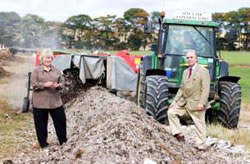
What's believed to be a unique reclamation project is using up over 7,000 tonnes a year of industrial waste and at the same time providing a new fertiliser to farms in Aberdeenshire.
The scheme is the brainchild of Dyce farmer Andrew Macfarlane and staff at International Paper's Inverurie mill.
"We're taking two wastes - the paper mill's effluent and farmyard manure - and composting them together into fertiliser", says Macfarlane.
Thirty-five local farms are involved in the scheme, which is entering its third year. Macfarlane says that while it's too soon to compare 'before and after' results in terms of crop yields, there's a clear sign of the new fertiliser's effectiveness. Almost every farmer who's tried it out has signed up for another year's supply.
A year's waste from the Inverurie mill would cover a full-sized football pitch a metre deep. It consists mostly of chalk and paper fibre, at first in a liquid mix, then dried and compacted to a material called 'crumble'. A contractor collects around 20 tonnes of wet waste from the mill each day. This is then taken directly to fields on local farms, where it's laid down in long rows and mixed with a similar quantity of farmyard manure.
"Manure and mill waste were made for each other", says Andrew Macfarlane. The crumble is around 70% chalk, while the typical soil in central Aberdeenshire is acidic. Mixing the crumble with manure also gives excellent balance of carbon and nitrogen. Independent tests by the Soil Association confirm that the blend gives a highly nutritious compost.
The rows of mixed manure and crumble are usually turned four times over a four- to six-week period, using a specialised machine. Each turn allows oxygen into the mix. At the end of the process a transformation similar to that of a garden compost heap has taken place. The rows have a typical internal temperature of 35ºC, which encourages microbial activity to break down the fibres in the crumble and the straw in the manure. The temperature also helps to kill pathogens.
All the fields to be spread are soil sampled and analysed by the Scottish Agricultural College at Thainstone, in order to establish the optimum mix and spreading rate. The spreading process uses between 10 and 20 tonnes per acre depending on the soil requirement.
Macfarlane says that the compost should be ploughed in for best results, though he also spreads on grassland in the spring. His satisfaction comes from seeing a good crop, and the evidence of his eyes is that fields which have been composted are looking better than those next door which haven't.
International Paper's environment manager Helen Geddes is enthusiastic about the success of the project. "We have an excellent environmental record at Inverurie. We use renewable natural resources and our end product is itself renewable.
But we do produce waste - it's a harmless, semi-solid that's mostly chalk and paper fibre after effluent treatment – and we dispose of it responsibly. From an environmental view, it's 100% reclamation. We don't know of any other similar project in Britain. We hope it acts as a pilot.
The potential is for many more thousands of tonnes of paper mill waste to be put to productive use. All you need is a mill surrounded by farmland, preferably on acid soil; an entrepreneur like Andrew who understands farming - and cows to supply the manure!"
Before committing to the full project, International Paper and Andrew Macfarlane ran trials whose results satisfied the Scottish Environmental Protection Agency [SEPA].
Macfarlane's service is free to local farmers taking part in the scheme. The only cost is borne by International Paper, which pays him to collect its wet waste. International Paper's mill at Inverurie has been making quality paper since 1850. It employs 480 people.
Andrew Macfarlane farms near Dyce airport. He's a prominent farm consultant and for 10 years has been a member of the council of the National Farmers' Union of Scotland. He's also a past president of the Aberdeen and Kincardine Area of the NFUS and sits on its legal and technical committees.
